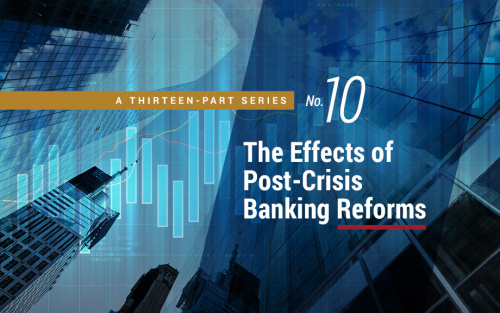The Side Effects of Shadow Banking on Liquidity Provision

Over the past two decades, the growth of shadow banking has transformed the way the U.S. banking system funds corporations. In this post, we describe how this growth has affected both the term loan and credit line businesses, and how the changes have resulted in a reduction in the liquidity insurance provided to firms.
How Do Large Banks Manage Their Cash?

As the aggregate supply of reserves shrinks and large banks implement liquidity regulations, they may follow a variety of liquidity management strategies depending on their business models and the interest rate differences between alternative liquid instruments. For example, the banks may continue to hold large amounts of excess reserves or shift to Treasury or agency securities or shrink their balance sheets. In this post, we provide new evidence on how large banks have managed their cash, which is the largest component of reserves, on a daily basis since the implementation of liquidity regulations.
Large Bank Cash Balances and Liquidity Regulations
Assessing the Price Impact of Treasury Market Workups

The price impact of a trade derives largely from its informational content. The “workup” mechanism, a trading protocol used in the U.S. Treasury securities market, is designed to mitigate the instantaneous price impact of a trade by allowing market participants to trade additional quantities of a security after a buyer and seller first agree on its price. Nevertheless, workup trades are not necessarily free of information. In this post, we assess the role of workups in price discovery, following our recent paper in the Review of Asset Pricing Studies (an earlier version of which was released as a New York Fed staff report).
Global Trends in Interest Rates

Long-term government bond yields are at their lowest levels of the past 150 years in advanced economies. In this blog post, we argue that this low-interest-rate environment reflects secular global forces that have lowered real interest rates by about two percentage points over the past forty years. The magnitude of this decline has been nearly the same in all advanced economies, since their real interest rates have converged over this period. The key factors behind this development are an increase in demand for safety and liquidity among investors and a slowdown in global economic growth.
What Can We Learn from the Timing of Interbank Payments?

From 2008 to 2014 the Federal Reserve vastly increased the size of its balance sheet, mainly through its large-scale asset purchase programs (LSAPs). The resulting abundance of reserves affected the financial system in a number of ways, including by changing the intraday timing of interbank payments. In this post we show that (1) there appears to be a nonlinear relationship between the amount of reserves in the system and the timing of interbank payments, and (2) with the increase in reserves, smaller banks shifted their timing of payments more significantly than larger banks did. This result suggests that tracking the timing of payments sent by banks could provide an informative signal about the impact of the shrinking Federal Reserve balance sheet on the payments system.
Stressed Outflows and the Supply of Central Bank Reserves
Price Impact of Trades and Limit Orders in the U.S. Treasury Securities Market

It’s long been known that asset prices respond not only to public information, such as macroeconomic announcements, but also to private information revealed through trading. More recently, with the growth of high-frequency trading, academics have argued that limit orders—orders to buy or sell a security at a specific price or better—also contain information. In this post, we examine the information content of trades and limit orders in the U.S. Treasury securities market, following this paper, recently published in the Journal of Financial Markets and earlier as a New York Fed staff report.
Did Banks Subject to LCR Reduce Liquidity Creation?

Banks traditionally provide loans that are funded mostly by deposits and thereby create liquidity, which benefits the economy. However, since the loans are typically long-term and illiquid, whereas the deposits are short-term and liquid, this creation of liquidity entails risk for the bank because of the possibility that depositors may “run” (that is, withdraw their deposits on short notice). To mitigate this risk, regulators implemented the liquidity coverage ratio (LCR) following the financial crisis of 2007-08, mandating banks to hold a buffer of liquid assets. A side effect of the regulation, however, is a reduction in liquidity creation by banks subject to LCR, as we find in our recent paper.
A DSGE Perspective on Safety, Liquidity, and Low Interest Rates

Marco Del Negro, Domenico Giannone, Marc Giannoni, Abhi Gupta, Pearl Li, and Andrea Tambalotti Third of three posts The preceding two posts in this series documented that interest rates on safe and liquid assets, such as U.S. Treasury securities, have declined significantly in the past twenty years. Of course, short-term interest rates in the United […]












 RSS Feed
RSS Feed Follow Liberty Street Economics
Follow Liberty Street Economics